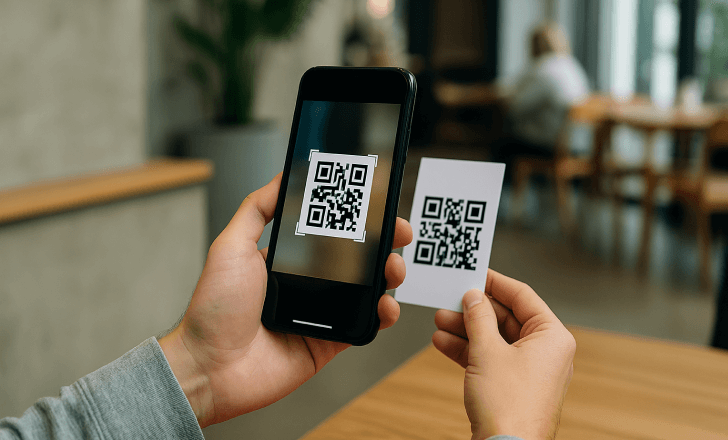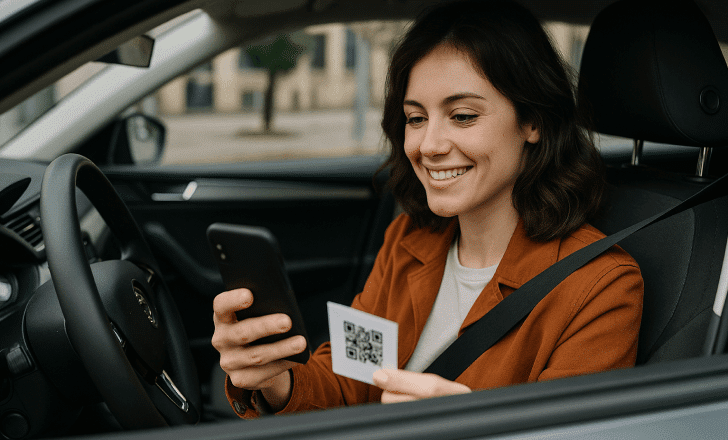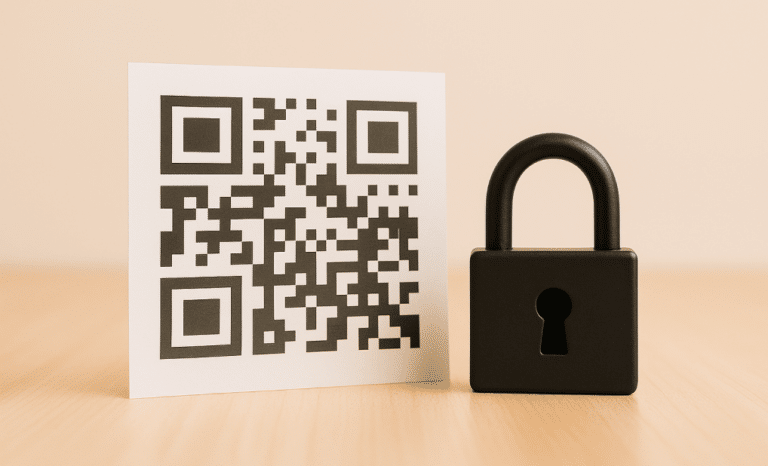QR codes are everywhere—from restaurant menus and event check-ins to payment portals and supply chain tracking. But as they’ve grown in popularity, they’ve also caught the attention of cybercriminals. When it comes to QR codes and cyber security, there’s more at stake than just convenience. These tiny patterns can be used to launch phishing attacks, steal credentials, and trick users into downloading malware.
So, how do you embrace the benefits of QR codes while staying safe from cyber threats? Let’s break it down.
Why QR codes pose new challenges for cyber security
The beauty of a QR code lies in its simplicity. Point your camera, tap a link, and you’re instantly connected. But that simplicity also creates a unique vulnerability. When users scan a QR code, they often trust the destination without knowing exactly where the code will take them.

A silent opportunity for threat actors
Unlike traditional phishing emails that might raise red flags, malicious QR codes can easily evade detection. They’re often embedded into printed materials or public displays, making it harder to verify their legitimacy. A threat actor could place a sticker over an original QR code—on a poster, a parking meter, or even a restaurant table—and replace it with a malicious site.
In one real-world case, attackers used QR code phishing (also called quishing attacks) to redirect users to a fake login page that mimicked Microsoft 365. Victims scanned the code, entered their login credentials, and unknowingly handed over access to their corporate systems.
How QR code phishing works (and why it’s hard to detect)
QR code phishing works just like traditional phishing but in disguise. Instead of clicking a suspicious email link, the user scans a QR code—often from a trusted-looking source. The QR code might then:
- Redirect to a phishing site designed to look legitimate
- Trigger a download of malicious software
- Open a payment portal to steal financial data
- Access a fake login page to collect user accounts and sensitive information
Once the user takes action, the damage is done—bad actors can gain access to emails, payment platforms, or even entire enterprise networks.
Social engineering meets QR codes: A dangerous combo
Social engineering tactics play a major role in successful QR code attacks. Cybercriminals rely on user trust and familiarity to trick people into acting quickly. QR codes often appear in contexts where users expect speed—contactless transactions, ticketing, or restaurant menus.
For example, a scam QR code on a flyer might say “Scan here to claim your gift card,” appealing to curiosity or urgency. The attacker is betting you won’t carefully verify the link destination, especially in a rush.

Risks associated with QR codes in corporate environments
For companies, QR codes offer innovative uses—from tracking inventory in the supply chain to facilitating fast employee onboarding. But they also open up new security threats:
- Employees might scan fraudulent QR codes with mobile devices connected to the network.
- Internal documents shared via QR codes could be intercepted or replaced.
- A QR code linking to an internal tool could become an entry point for attackers if not properly secured.
This blend of convenience and vulnerability makes QR codes a potential weak link in cyber security strategies.
The role of device settings and QR scanners
Not all QR scanners are created equal. Many default camera applications immediately open the embedded link without prompting for confirmation, leaving users exposed. A better alternative is to use security-focused apps that preview URLs and check for malicious links.
Users should also avoid scanning codes from unknown sources and disable automatic redirects when possible. On corporate mobile devices, IT teams can implement advanced security tools to monitor scanning behavior and flag suspicious activity.
Real-world consequences of QR code cyber attacks
The stakes are high. Some of the most common impacts of QR code attacks include:
- Stealing money from fake payment portals
- Exfiltration of sensitive data, such as financial information or client records
- Distribution of spyware that tracks online activity
- Hijacking user sessions to access social media, email, or banking apps
- Unauthorized access to company portals through stolen login credentials
One compromised scan can create a ripple effect across systems, especially when QR codes are embedded in cross-platform workflows.
Are all QR codes dangerous?
Absolutely not. QR codes themselves are neutral—it’s how they’re used that matters. Most QR codes are harmless and used by businesses for legitimate, helpful purposes. The issue arises when you can’t distinguish between a trustworthy source and a fraudulent QR code.
So, the question isn’t whether to stop using QR codes, but rather how to use them safely and responsibly.

How can businesses secure their QR code campaigns?
Companies embedding QR codes into campaigns should follow a few key steps to ensure data integrity and minimize cyber threats:
- Use a secure platform like QR Code KIT that protects links and monitors for suspicious behavior.
- Always use HTTPS URLs and domains you control.
- Customize your codes to include logos, colors, or frames that help users recognize authenticity.
- Avoid public reprinting—once a code is distributed, changing its link without a dynamic QR code platform is risky.
- Include a visible, human-readable URL or company name below the code to build trust.
By taking these precautions, you reduce the risk of someone hijacking your campaign with a malicious QR code.
How can users safely scan QR codes?
Whether you’re a casual user or an employee in a high-security environment, here are a few smart practices to stay protected:
- Pause before you scan: If the QR code appears in a sketchy context or looks tampered with, walk away.
- Preview the link: Use apps or browser extensions that show you where the code leads before opening it.
- Avoid scanning QR codes on unsolicited flyers, email attachments, or suspicious packaging.
- Don’t input sensitive info into a form unless you’re sure of the destination’s authenticity.
- Educate yourself on the types of scams currently circulating—knowledge is power.
When in doubt, don’t scan. It’s that simple.
Can QR codes be used to download malware?
Yes, but not directly. Scanning a QR code won’t automatically install anything on your device. However, it can direct users to a malicious website that prompts them to download a file or install an app. That’s where the danger lies.
In a quishing attack, the attacker masks the real intent by dressing up the landing page as something legitimate—like a browser update, PDF download, or invoice. Once installed, the file could steal sensitive data, log keystrokes, or track online activity.
What should you do if you fall for a fraudulent QR code?
If you’ve accidentally scanned a suspicious QR code and entered your information:
- Immediately change your passwords, especially if it involved user accounts or login credentials.
- Enable two-factor authentication where possible.
- Monitor your financial data and accounts for unusual activity.
- Run a full malware scan on your device.
- Notify your employer if the scan involved any corporate systems.
Early detection can help you limit damage and prevent further cyber attacks.
Are QR codes safe to use in payment systems?
QR codes are increasingly used in payment systems worldwide, from contactless transactions at cafes to peer-to-peer payments. When implemented correctly, they’re secure. But if a malicious actor replaces the code on a checkout screen or payment terminal, your funds could be redirected to a fraudulent account.
To reduce this risk:
- Verify the payment portal URL matches the merchant
- Use official apps when possible
- Confirm the amount and payee details before confirming
- Avoid using public Wi-Fi for payment transactions

What’s the future of QR code security?
As adoption grows, so will the risks—and the defenses. We’ll see more platforms investing in built-in security layers like real-time scan monitoring, domain whitelisting, and AI tools to detect fraudulent behavior.
At the same time, educating users remains essential. No matter how advanced the tech gets, a well-designed social engineering attack can still trick someone into scanning the wrong code.
Cyber security in the age of QR codes requires a shared effort between platforms, developers, companies, and individuals.

Final thoughts
QR codes offer tremendous value—but they’re not immune to abuse. With more awareness, better tools, and smart habits, you can enjoy the convenience of QR codes while avoiding the traps set by cybercriminals. The goal isn’t to avoid scanning—it’s to scan smarter.
Can QR codes be used in phishing attacks?
Yes. QR code phishing involves directing users to fake websites that mimic legitimate login pages. These scams often steal credentials, payment info, or sensitive data.
How can you tell if a QR code is malicious?
Look for signs like stickers over existing codes, poorly printed labels, or suspicious contexts. Always verify the URL and avoid scanning from unknown sources.
Are free QR code generators safe to use?
It depends. Not every free QR code generator is created with security in mind. Some may lack the protections needed to prevent malicious redirection or offer no control over link management. That’s why it’s important to choose a platform with a strong reputation and clear security standards.
For example, QR Code KIT is a secure and reliable platform that complies with international standards such as ISO 27001, ISO 9001, ISO 14001, and the latest IEC ISO 18004:2024 for QR codes. It also actively monitors for suspicious activity to help prevent misuse.
Best of all, it offers a Free Plan that lets you create up to 2 free dynamic QR codes—giving you full access to professional features without compromising security.
When in doubt, do your research. Choosing a reputable tool makes all the difference in keeping your QR code campaigns—and your data—safe.
